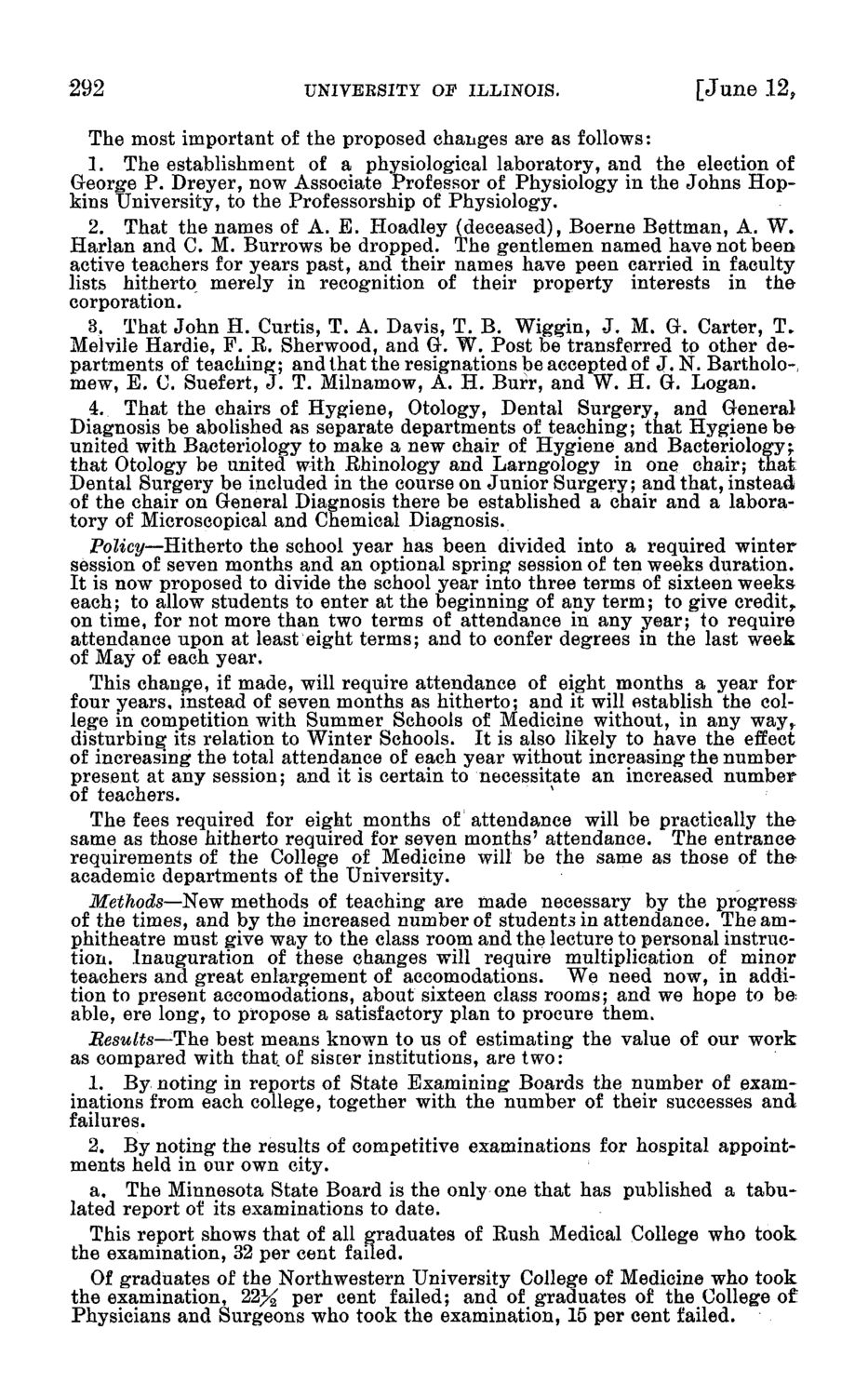| |
| |
Caption: Board of Trustees Minutes - 1900
This is a reduced-resolution page image for fast online browsing.

EXTRACTED TEXT FROM PAGE:
292 UNIVERSITY O F I L L I N O I S . [June 12, The most important of the proposed changes are as follows: 1. The establishment of a physiological laboratory, and the election of George P. Dreyer, now Associate Professor of Physiology in the Johns Hopkins University, to the Professorship of Physiology. 2. That the names of A. E. Hoadley (deceased), Boerne Bettman, A. W* Harlan and C. M. Burrows be dropped. The gentlemen named have not been active teachers for years past, and their names have peen carried in faculty lists hitherto merely in recognition of their property interests in the corporation. 8, That John H. Curtis, T. A. Davis, T. B. Wiggin, J . M. G. Carter, T. Melvile Hardie, F. B. Sherwood, and G. W. Post be transferred to other departments of teaching; and that the resignations be accepted of J . N . Bartholo-, mew, E. C. Suefert, J. T. Milnamow, A. H. Burr, and W. H. G. Logan. 4. That the chairs of Hygiene, Otology, Dental Surgery, and General Diagnosis be abolished as separate departments of teaching; that Hygiene be united with Bacteriology to make a new chair of Hygiene and Bacteriology;, that Otology be united with Rhinology and Larngology in one chair; that Dental Surgery be included in the course on Junior Surgery; and that, instead of the chair on General Diagnosis there be established a chair and a laboratory of Microscopical and Chemical Diagnosis. Policy—Hitherto the school year has been divided into a required winter session of seven months and an optional spring session of ten weeks duration. It is now proposed to divide the school year into three terms of sixteen weeks each; to allow students to enter at the beginning of any term; to give credit,, on time, for not more than two terms of attendance in any year; to require attendance upon at least eight terms; and to confer degrees in the last week of May of each year. This change, if made, will require attendance of eight months a year for four years, instead of seven months as hitherto; and it will establish the college in competition with Summer Schools of Medicine without, in any way r disturbing its relation to Winter Schools. It is also likely to have the effect of increasing the total attendance of each year without increasing the number present at any session; and it is certain to necessitate an increased number of teachers. The fees required for eight months of attendance will be practically the same as those hitherto required for seven months' attendance. The entrance requirements of the College of Medicine will be the same as those of the academic departments of the University. Methods—New methods of teaching are made necessary by the progress of the times, and by the increased number of students in attendance. The amphitheatre must give way to the class room and the lecture to personal instruction. Inauguration of these changes will require multiplication of minor teachers and great enlargement of accomodations. We need now, in addition to present accomodations, about sixteen class rooms; and we hope to be able, ere long, to propose a satisfactory plan to procure them. Besults—The best means known to us of estimating the value of our work as compared with that of siscer institutions, are two: 1. By noting in reports of State Examining Boards the number of examinations from each college, together with the number of their successes and failures. 2. By noting the results of competitive examinations for hospital appointments held in our own city. a. The Minnesota State Board is the only one that has published a tabulated report of its examinations to date. This report shows that of all graduates of Rush Medical College who took the examination, 32 per cent failed. Of graduates of the Northwestern University College of Medicine who took the examination, 22% per cent failed; and of graduates of the College of Physicians and Surgeons who took the examination, 15 per cent failed.
| |